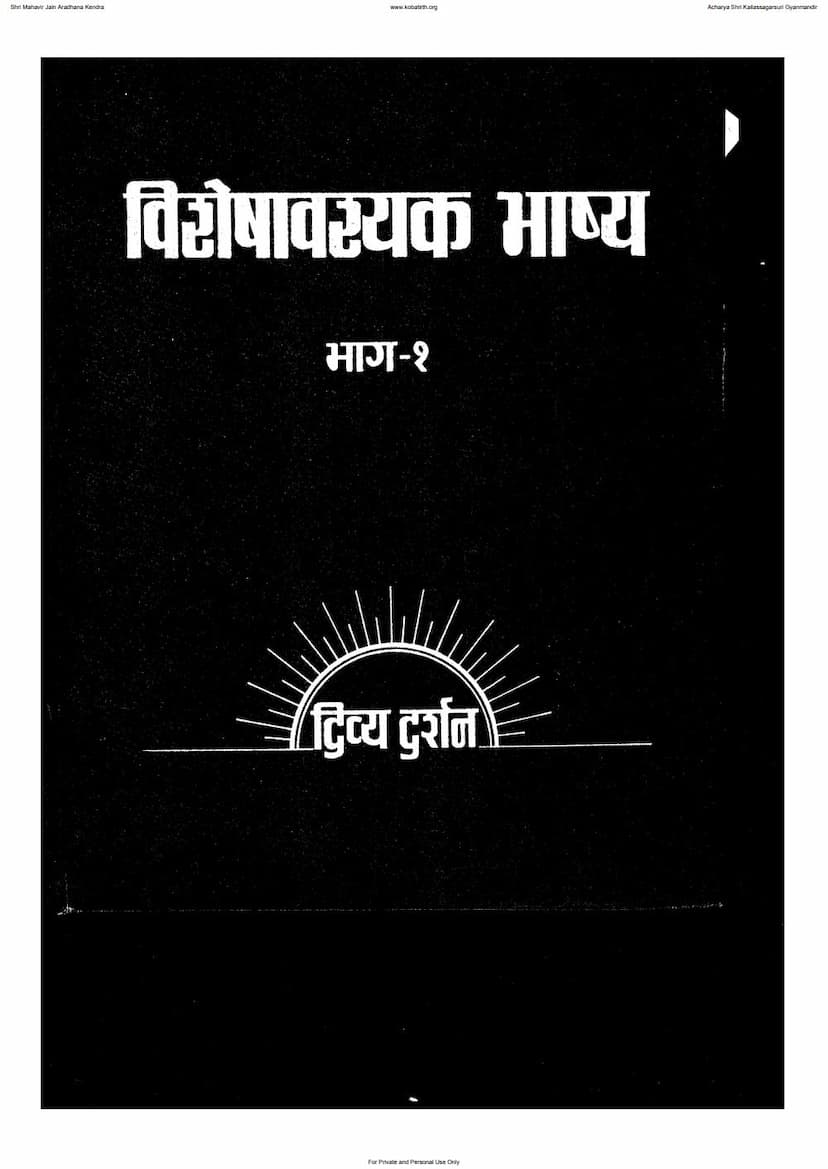Visheshavashyak Bhashya Part 01
Added to library: September 2, 2025

Summary
This is a comprehensive summary of the provided Jain text, "Visheshavashyak Bhashya Part 01" by Divyadarshan, based on the page snippets you've shared. The text is dense with philosophical discussions, particularly concerning knowledge (jnana), perception, and the categories of Jain ontology and epistemology.
Overall Scope:
The "Visheshavashyak Bhashya" appears to be a highly detailed commentary on the fundamental principles of Jainism, likely focusing on the Avashyaka (essential duties) and related concepts. The provided table of contents and text snippets reveal a deep dive into:
- Epistemology (Praman Shastra): Extensive analysis of different types of knowledge (mati, shruta, avadhi, manahparyaya, keval) and their characteristics, sources, and distinctions. It addresses various philosophical schools (nayas) and debates within them.
- Ontology (Dravya Shastra): Discussions on substances, their attributes, and classifications, including an understanding of the Jain concept of reality.
- Ethics and Practice: References to monastic codes (sthavirakalpa), conduct of ascetics, and various aspects of Jain practice, including the importance of auspicious beginnings (mangala) and proper disciple-teacher interaction.
- Theological and Cosmological Elements: Mentions of Mahavir, Tirthankaras, and various levels of existence like Devas and Naraka inhabitants, which are relevant to understanding the application of Jain principles.
- Linguistic and Terminological Analysis: A significant portion of the text seems dedicated to etymological explanations of key Jain terms and concepts, exploring their various interpretations and nuances.
Key Themes and Concepts Identified:
-
Mangala (Auspiciousness/Beginnings):
- The text begins with discussions on mangala, its purpose (preventing obstacles, initiating auspicious actions), and the meaning of the three types of mangala (divine, elemental, action-based).
- It delves into the etymology of "mangala" and its application at the beginning, middle, and end of a text.
- There's a detailed refutation of the idea that a text inherently auspicious does not need a mangala, and a justification for why mangala is still necessary.
-
Anuyoga (Systematic Exposition):
- The text emphasizes the importance of anuyoga as a systematic method of exposition.
- It explains the purpose and classification of anuyoga, linking it to the study of Avashyaka texts.
- The text also outlines the structure of an anuyoga, including sections on purpose (phala), connection (yoga), mangala, community meaning (samudayartha), doors (dwaras), etymology (nirukti), order (krama), and purpose (prayojana).
-
Avashyaka (Essential Duties):
- The core subject is the Avashyaka, which is described as the foundation of virtuous conduct.
- Its significance is highlighted in leading to spiritual liberation.
- The text discusses the Avashyaka as being intrinsically linked to knowledge, action, and the path to moksha (liberation).
-
Knowledge (Jnana) and Perception (Pramana):
- A substantial portion is dedicated to the five types of valid knowledge in Jainism:
- Mati-Shruta Jnana (Sensory and Scriptural Knowledge): Detailed exploration of these two primary forms of knowledge, their interrelation, the role of senses, the process of perception (avagraha, iha, apaya, dharna), and the concept of inference.
- Avadhi Jnana (Pure Sensory Knowledge): Discussion on its scope, limitations, and characteristics.
- Manahparyaya Jnana (Mind-Reading Knowledge): Its nature, scope, and limitations.
- Keval Jnana (Omniscience): Its perfect and complete nature.
- The text engages in philosophical debates regarding the nature of knowledge, whether it is an attribute of the soul (jiv) or the object, and the role of inferential versus direct knowledge.
- The distinction between knowledge (jnana) and perception (darshana) is a recurring theme.
- A substantial portion is dedicated to the five types of valid knowledge in Jainism:
-
Nayas (Standpoints/Perspectives):
- The text extensively discusses various nayas (philosophical standpoints) like sangraha, vyavahara, * Shabda*, sthapanana, dravya, bhava, and their role in understanding reality and knowledge.
- It highlights how different nayas provide different perspectives on the same reality and how a comprehensive understanding requires considering all of them.
- There are detailed arguments and counter-arguments between proponents of different nayas, particularly regarding the nature of reality, universals, and particulars.
-
Monastic Life and Conduct:
- References to sthavirakalpa (a traditional monastic order), the stages of a monk's life (pravajya, shiksha, acharya pada), and the importance of the teacher's guidance (gurupadesha).
- Discussions on specific practices like samayika (meditation/equanimity), kashaya (passions), and various types of conduct.
-
Scriptural Analysis:
- The text mentions and analyzes various concepts within Jain scriptures like Nandi Sutra, Shatkhandagama, and possibly others, referencing their content and the interpretations of previous scholars (like Hemchandrasuri).
- There's a clear emphasis on the importance of studying scriptures to gain correct knowledge.
Structure and Methodology:
- Deductive Reasoning: The text employs rigorous logical reasoning, presenting arguments and counter-arguments, akin to a philosophical debate.
- Etymological Analysis: Deep dives into the meaning and origin of key Sanskrit and Prakrit terms are evident.
- Comparative Philosophy: It frequently contrasts Jain views with those of other philosophical schools (e.g., Buddhist, Mimamsa) and critically refutes them.
- Analogies and Examples: The text uses various examples and analogies (e.g., lamp, pot, horse, bird) to illustrate complex philosophical points.
Overall Impression:
The "Visheshavashyak Bhashya Part 01" is a foundational Jain text that meticulously dissects and explains core epistemological and ontological principles. It demonstrates a profound understanding of Jain philosophy, emphasizing the interconnectedness of knowledge, conduct, and liberation. The author and commentators aim to provide a clear and comprehensive understanding, addressing potential doubts and criticisms through detailed logical arguments. The work is clearly intended for serious students of Jain philosophy.